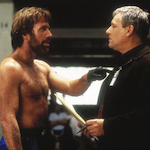 May 3, 1985
May 3, 1985
Just like with GYMKATA, I’ve reviewed CODE OF SILENCE before, and I had some good jokes in there. I also wrote about it a little in Seagalogy, as a comparison to ABOVE THE LAW. But it’s one of the movies that was playing when the summer of ’85 began, and representative of the type of action movies that were summer moviegoing events in those days. So I thought it was important to revisit. And just do a quick 3,000 word deep dive.
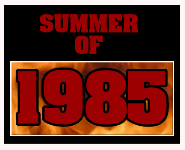 CODE OF SILENCE stars Chuck Norris as respected Chicago P.D. sergeant Eddie Cusack, part of a team trying to take down coke gang brothers the Comachos. He’s spent a month planning a sting operation that goes horribly wrong in two ways. First, a rival gang coincidentally goes in right before them and machine guns all the Comachos, kicking off a brutal gang war. Second, one of the guys on his team shoots and kills a young civilian in the apartment building hallway. As a cop with a moral code, a strong work ethic and good karate kicks, Cusack will spend the movie trying to deal with the repercussions of both of these things. Also there’s a robot.
CODE OF SILENCE stars Chuck Norris as respected Chicago P.D. sergeant Eddie Cusack, part of a team trying to take down coke gang brothers the Comachos. He’s spent a month planning a sting operation that goes horribly wrong in two ways. First, a rival gang coincidentally goes in right before them and machine guns all the Comachos, kicking off a brutal gang war. Second, one of the guys on his team shoots and kills a young civilian in the apartment building hallway. As a cop with a moral code, a strong work ethic and good karate kicks, Cusack will spend the movie trying to deal with the repercussions of both of these things. Also there’s a robot.
Let’s set the scene a little. Norris was already well established as a movie star, having released one movie a year since ’77 (and two in ’82). His first independent starring vehicles BREAKER! BREAKER!, GOOD GUYS WEAR BLACK and A FORCE OF ONE were all successful, leading to studio releases THE OCTAGON, AN EYE FOR AN EYE, SILENT RAGE, FORCED VENGEANCE and LONE WOLF McQUADE. MISSING IN ACTION, his first film on a new multi-picture deal with Cannon, had been a big hit.
And then all the sudden in 1985 he released three movies. Two of his Cannon movies, MISSING IN ACTION 2: THE BEGINNING and the classic INVASION U.S.A. came out in March and September, respectively. In the middle of that, in the summer, was this release from Orion Pictures, whose early ‘80s action successes include FIRST BLOOD and THE TERMINATOR. CODE OF SILENCE is one of Norris’s best and most legit movies, and I credit that quality to director Andrew Davis.
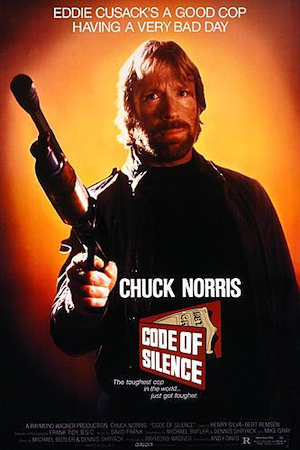 It’s Davis’s third movie, but his first action movie, to be followed by ABOVE THE LAW, THE PACKAGE, UNDER SIEGE and THE FUGITIVE all in a row. Obviously I’m partial to ABOVE THE LAW, but much of what he did so well there started here: the textured depiction of life in Chicago, the cast of tough guy character actors, some of them ex-cops and musicians. Some of that came out of his first movie STONY ISLAND (1978), which was about musicians in his neighborhood on the south side of Chicago, and starred his guitarist brother Richard, saxophonist Gene Barge and singer/keyboardist Ronnie Barron (the latter two returning here).
It’s Davis’s third movie, but his first action movie, to be followed by ABOVE THE LAW, THE PACKAGE, UNDER SIEGE and THE FUGITIVE all in a row. Obviously I’m partial to ABOVE THE LAW, but much of what he did so well there started here: the textured depiction of life in Chicago, the cast of tough guy character actors, some of them ex-cops and musicians. Some of that came out of his first movie STONY ISLAND (1978), which was about musicians in his neighborhood on the south side of Chicago, and starred his guitarist brother Richard, saxophonist Gene Barge and singer/keyboardist Ronnie Barron (the latter two returning here).
An IMDb search says CODE OF SILENCE and ABOVE THE LAW share 43 cast and crew members. The most obvious one is Henry Silva (SHARKY’S MACHINE), who plays the drug lord villain of both. (Different character, sadly.)
Another thing they have in common: action stars now known as conservatives starring in movies about problems that are taboo for modern conservatives to even acknowledge the existence of – in ABOVE THE LAW the Iran-Contra scandal, in CODE OF SILENCE a racist police killing and coverup.
The killer is Detective Cragie (Ralph Foody, RAW DEAL), a 30 year veteran of the force who drinks his “nerve tonic” (Southern Comfort) in a cemetery while waiting for the sting to start, encouraging his nervous younger partner Nick Kopalas (Joseph Guzaldo, HERO AND THE TERROR) to piss on the graves. He storms the building after everything is over and shoots a kid who steps out into the hallway. (It’s not clear from the credits who played the kid, and we don’t find out much about him, but he looks black and Latino to me.) He knows to pull a small gun from an ankle holster to plant on him. He does sense that Kopalas will object, putting on an act and saying “It’s okay, I got the sonofabitch. Cover the stairs.” But Kopalas clearly doesn’t feel good about it.
Later Cragie has to face a hearing with the Citizen’s Review Board. The other cops ask no questions, rally behind him, pass a petition around, which Kopalas nervously signs. A great moment is when Brennan (Ron Dean, THE TOUGHEST MAN IN THE WORLD) asks Cusack to sign and he says, “I pass.” Total shock. Nobody expected anybody to pull a Serpico move like that. Brennan starts saying shit like “So he made a couple of mistakes. The man was a hero!” The confrontation seems very authentic and makes Cusack into a good hero, especially since it happens during a kickboxing session that the movie randomly drop us into with context. Look, you’ll see later that the man can kick. You don’t need to know how hard he trains for it, but you don’t need it hidden from you either.
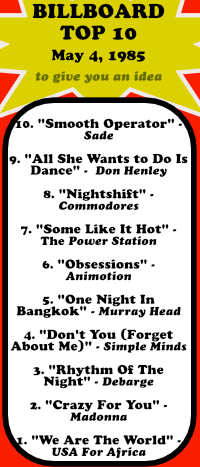 It’s not clear to me if Davis intends to comment on the racial dynamics of policing, but there’s stuff there for you to notice. There’s a comical scene where a black man (Zaid Farid, “Street Dude,” ABOVE THE LAW) walks into the tavern where the cops hang out and every head turns to watch him suspiciously. In this case we know they happen to be correct, because he and a white guy (Dennis Cockrum, THE GLIMMER MAN) are planning to rob the place (who the fuck tries to stick up everybody in a crowded bar?), but the way it goes it’s easy to assume they’re profiling him. “Hey, wait a minute, there’s only one black guy that comes in here and he’s already here. Who’s this one?”
It’s not clear to me if Davis intends to comment on the racial dynamics of policing, but there’s stuff there for you to notice. There’s a comical scene where a black man (Zaid Farid, “Street Dude,” ABOVE THE LAW) walks into the tavern where the cops hang out and every head turns to watch him suspiciously. In this case we know they happen to be correct, because he and a white guy (Dennis Cockrum, THE GLIMMER MAN) are planning to rob the place (who the fuck tries to stick up everybody in a crowded bar?), but the way it goes it’s easy to assume they’re profiling him. “Hey, wait a minute, there’s only one black guy that comes in here and he’s already here. Who’s this one?”
Later there’s sort of a mirror image scene where Cusack walks into the pool hall frequented by Comacho’s men and somebody says “Hey, you don’t want to be in here.” (That’s where he says “If I want your opinion I’ll beat it out of you” – Chuck’s most quoted line?) And he acknowledges that they’re primarily Latino by calling one of them “amigo.”
It’s a good scene, though. They swarm around him like Japanese honey bees on a murder hornet. He puts up a valiant fight and manages to survive the gauntlet for a few minutes, but they don’t pretend he can do the impossible this time.
The climax of the movie happens after the hearing. Kopalas wusses out from telling the truth about the shooting, and even Cusack, who’d advised him to “tell it like it is,” doesn’t give up Cragie. He does, however, admit under questioning that he already believed Cragie shouldn’t be on the streets. Even just that minor case of telling part of the truth under oath causes outrage on the force, everyone taunting him and treating him like a traitor and pariah on his way out. So when he finds out where Comacho is gonna be he calls for backup and everybody pretends they have to wash their hair that day. He has to take on a heavily armed drug gang without any help.
Well, without any help from human beings, at least. He does have that robot helping him.
Let me explain. It’s not a ROCKY IV type robot. It’s something called PROWLER, kind of a remote controlled (but also automated) mini-tank that drives around and has built in cameras, heat sensors, Doppler radar, guns and rocket launchers. I’ve always laughed at this aspect of the movie, but it turns out it’s less silly than I thought. The end credits name a company called Robot Defense Systems Inc. of Thornton, Colorado. They were founded in 1983, and are still listed on Bloomberg.com as a company that produces “mobile robotic vehicles for military and commercial security applications worldwide,” though I’ve read elsewhere that they went out of business.
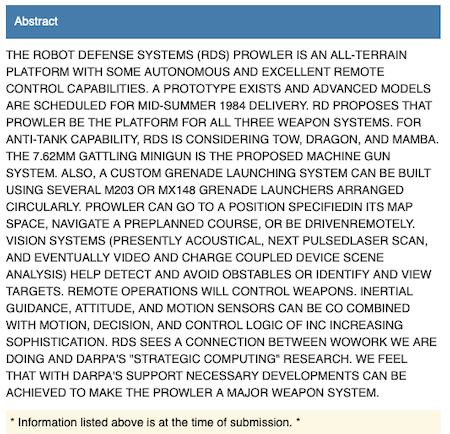
It turns out PROWLER stands for “Programmable Robot With Logical Enemy Response” and was a real, working prototype, or at the very least RDS portrayed it as such when DARPA awarded them a $50,000 grant in 1984. According to Killer Robots: Legality and Ethicality of Autonomous Weapons by Armin Krishnan, “PROWLER was a two ton sentry robot vehicle that could be armed with various weapons like machine guns or grenade launchers and could be programmed to fire at will.”
In the movie PROWLER is introduced in the first half hour, in what seems like a satirical or at least critical context. It plays pre-recorded messages in a calm female voice out of a dystopian sci-fi film. Factory representative John Mahoney smiles like a kid as he controls it; Cusack looks on grimly. Commander Kates (Bert Remsen, NASHVILLE, CARNY, ARMY OF ONE) says, “You’re looking at the perfect cop. Damn thing follows orders.” Cusack says, “Another gun without a brain” and struts out.
Then he pulls a trick that maybe someone can explain to me, because I’ve never been able to decode what happens. They try to use Cusack for the demonstration, telling him to put down his weapon, but he pulls his gun and makes Mahoney put down the remote, and the robot thanks him for his cooperation. I don’t really get it, but I have come to believe that it’s the inspiration for the classic ED-209 demonstration scene in ROBOCOP.
So anyway, at the end no cop will help Cusack because he didn’t fully lie on the stand, so he steals PROWLER and it helps him kill the entire drug gang in the warehouse. I believe the robot terminates nine human lives and Cusack even more. The rest of the force finally decides to show up after he’s done, and I guess they respect him now because he killed Comacho?
Obviously I like Cusack better than Cragie, and we have the moviegoer’s luxury of knowing they’re all guilty, but he straight up massacres them. He shoots Camacho in the back. During the sting at the beginning he punches out a guy that surrendered and blindly fires a bunch of shots at a car fleeing down a street where people live. (Hopefully if he’d hit people he wouldn’t have planted guns on them.)
And I think the movie cops out on its message in the scene where Kopalas finally says what really happened, and the other cops look at Cragie with disgust as they walk away. We’re all very familiar with cases where police kill unarmed innocent people, some of them in the back, some of them children, often on video, with very public lies and cover ups, and almost always they’re universally backed by other police. In rare cases where they’re fired, sometimes the police union forces them to be rehired, or they’re hired in another jurisdiction. The earlier scenes where everyone automatically supports killing a kid ring much more true.
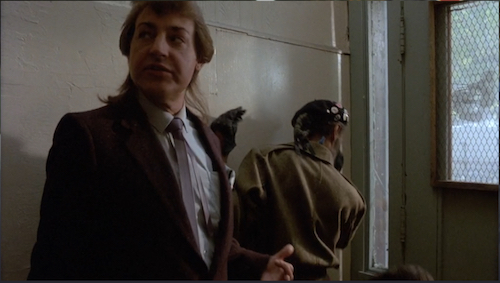
All of these silence code related issues are actually kind of happening in the background of this gang war, Cusack’s attempts to find the bosses and to protect one guy’s innocent daughter (Molly Hagan, THE DENTIST, SULLY). Silva looks like a suave, beautiful alien as lead villain Luis Comacho, but it’s the colorful small time hoods that really stand out. I especially like the coke deal scene at the beginning, where two guys named Spider (Wilbert Bradley, TEACHERS) and Doc (Ronnie Barron) go to an apartment to meet with Victor Comacho (Ron Henriquez, WILLIE DYNAMITE). Spider (who is an informant, and speaks to the cops in baseball-themed code) wears a beret covered in pins. Doc sports an impressive mullet and carries a trombone case.
I immediately recognized him as the obnoxious “CIA Bartender” from ABOVE THE LAW, and I’ve noted that his voice and accent sound like Dr. John. Turns out he was a singer and keyboardist and in fact played on several of Dr. John’s albums (as well as with Canned Heat and Tom Waits and as a solo artist). He was good!
Spider has a good line when they get frisked at the door (“We oughta get married, me and you!”) but it’s Doc who really dominates the scene, getting mouthy with Camacho for not shaking his hand. In other scenes the police get good bits, like when one says of a hanging dead body, “Looked like somebody tried ta carve a canoe out of ‘im.” Dorato (Dennis Farina after THIEF but before MANHUNTER) is Cusack’s injured partner and comic relief who spends most of his scenes pitching new business ideas (including an alligator farm) but does at one point run around on a leg cast without crutches to back him up.
I like the detail that Cusack is frequently playing with a Rubik’s Cube, even during the sting operation (although that was a couple years after the height of the fad, so at the time it probly seemed corny). Also there’s kind of a funny scene at a gallery opening (for a painter known for his “Dead Dog Series”) where Cusack ruins a cocaine party by loudly saying “This is Sergeant Cusack” on a phone call. Respect to the screenplay by Michael Butler & Dennis Shryack (THE GAUNTLET) and Mike Grey (THE CHINA SYNDROME, WAVELENGTH), which was originally written in ’79, intended as the fourth DIRTY HARRY movie. (Since PROWLER wasn’t invented yet, I don’t think Harry would’ve had a robot pal.)
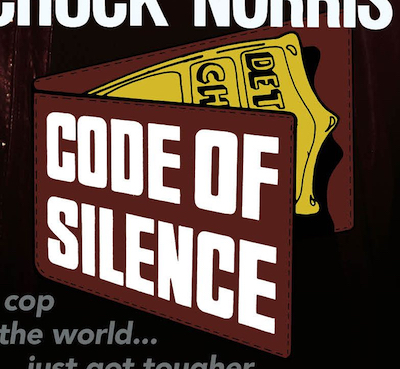
Davis is the son of an actor – his dad, Nathan, plays the gangster Felix Scalese, and was in THIEF, TOUGH GUYS and POLTERGEIST III – but he got his degree in journalism. His interest in politics helped get him into movies, working as a camera assistant for Haskell Wexler on MEDIUM COOL. Next thing you know he was a cinematographer for blaxploitation movies; I don’t think I ever made the connection that he shot Pam Grier and Bernie Casey in COOL BREEZE and HITMAN a decade and a half before he directed them in ABOVE THE LAW and UNDER SIEGE. He also shot THE SLAMS starring Jim Brown and the first in the ANGEL series, so it makes sense that he and cinematographer Frank Tidy (THE DUELLISTS) do such a good job shooting these raw looking situations on streets and in dingy apartments.
I love the immersive way he portrays Chicago, in what always look like authentic, weathered locations where you can hear cars driving by, dogs barking, kids playing, TVs or radios blaring from nearby apartments or windows. Graffiti and garbage never look fake the way they do in, say, RUMBLE IN THE BRONX. There are at least two appearances of Halloween decorations, but it’s not part of the plot, so I bet they were just there.
And it’s put together in a thoughtful way. The movie opens with shots of Chicago at night, zeroing in on the L train shooting sparks on a bridge, then it pans across all the police dispatchers hard at work. We’re introduced to Cusack in the day time, under the L train bridge, undercover as a garbage collector. Later a chase will go onto the train, onto the roof, off a bridge into water. And we’ll return to the dispatcher for the scene where no one will accept the backup call.
It might seem classier with a different score, although I get a kick out of this very dated one. It’s composer David M. Frank’s first action movie. He’d mostly done TV movies and the Bad News Bears TV series, but subsquently scored THE GLADIATOR, ABOVE THE LAW, HERO AND THE TERROR, ONE MAN FORCE, HARD TO KILL, OUT FOR JUSTICE, SHOWDOWN IN LITTLE TOKYO, BEST OF THE BEST II, STREET KNIGHT, EXTREME JUSTICE and PERFECT TARGET. So it seems to have worked out well for him. At times it sounds kind of like COMMANDO, but then it keeps popping into slap bass grooves that go for a while and then you get a keyboard solo and then a saxophone solo and then a little guitar noodling. It’s obviously very good session musicians teetering on the line between kinda funky and totally cheesy smooth jazz type business.
I have one more random thing I want to mention before wrapping up here. Due to my particular interests, I happened to notice that there were two scenes reminiscent of THE TEXAS CHAIN SAW MASSACRE. One is near the beginning when Cragie is drinking in the cemetery, reminding me of the old drunk in the cemetery at the beginning of TCSM.
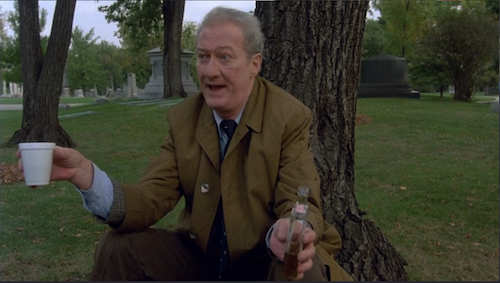
The other is at the end, when Diana Luna is tied up, and Comacho comes in planning to hit her over the head with a hammer.
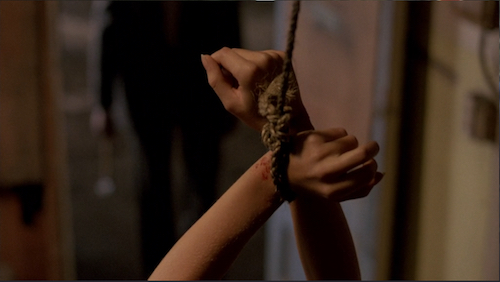
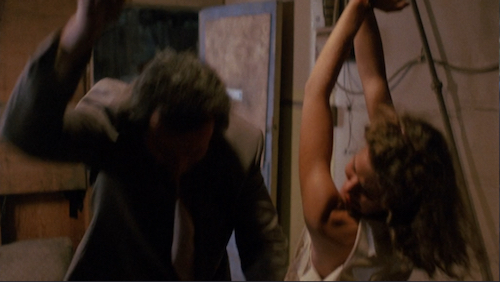
I don’t know what this means. Probly something, though.
CODE OF SILENCE opened at #1 against other new releases GOTCHA!, GYMKATA and PRIVATE RESORT (in limited release). #2 was LOST IN AMERICA in its eighth week, #3 was THE LAST DRAGON in its seventh week. Also in the top ten were the comedies JUST ONE OF THE GUYS, POLICE ACADEMY 2 and DESPERATELY SEEKING SUSAN. The only action competition was the previous week’s release STICK (#8) and BEVERLY HILLS COP, which came in at #10 in its 23rd week!
Maybe the Chicago setting buttered them up, but Siskel & Ebert were pretty positive about the movie. In his print review, Siskel compared it favorably to the previous two DIRTY HARRYs (which would be THE ENFORCER and SUDDEN IMPACT).
Of course I disagree with Siskel’s anti-kickboxing stance (and Ebert saying the robot isn’t real).
Washington Post critic Paul Attanasio accurately described it as “a conventional cop thriller leavened with a tablespoon of style and a quarter-cup of garbagey fun,” noting that the script “is dotted with bits of arcana, fragments of slang drawn from cop culture and the drug underworld that give it a nice texture,” and that “the movie has an unobtrusively daring editing style and use of sound, and a detailed sense of Windy City milieu.” That’s meaningful coming from a guy who later created Homicide: Life on the Street and wrote DONNIE BRASCO.
After a few viewings, I have determined that CODE OF SILENCE is pretty good.

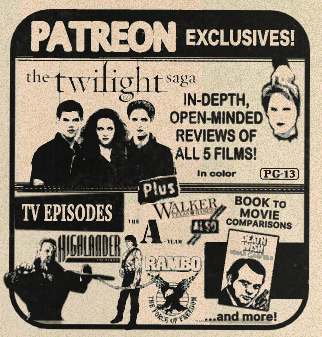
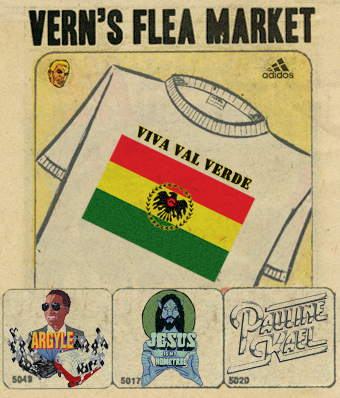
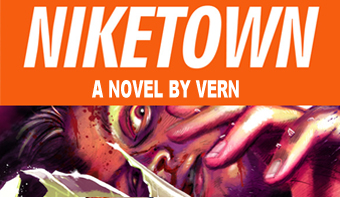
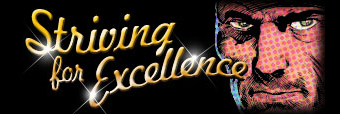
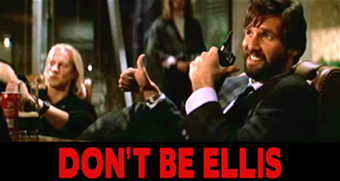
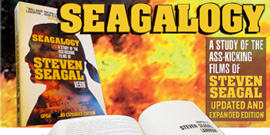
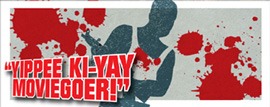








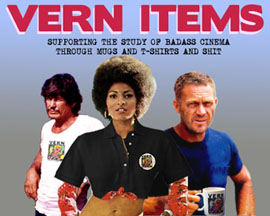
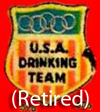
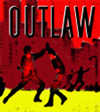






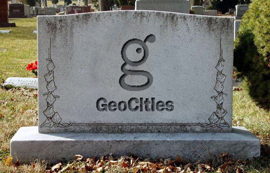
May 20th, 2020 at 1:20 pm
Maybe Chuck Norris best starring film. This and Lone Wolf McQuade are his only films that are actually good. I do enjoy some of the Missing Action films, The Delta Force (especially the theme song), even enjoy the sequel, and of course, Invasion USA is cheesy fun, but Code of Silence is pretty good, and I feel it’s all because of Andrew Davis.